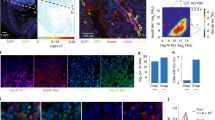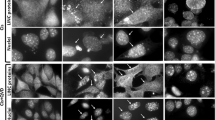Abstract
Apoptosis and necrosis, two morphologically distinct forms of cell death, can be induced by common stimuli depending on the doses and the cell type. This study compares the protective effect of oncoprotein Bcl-2 and of the small stress protein Hsp27 on these two types of cell death. We use rat embryo fibroblasts conditionally immortalized by the tsA58 mutant of SV40 large T antigen as parental cells to develop cell lines carrying inducible bcl-2 or hsp27 genes. Two apoptotic stimuli were used: shift to the restrictive temperature that induced p53-mediated apoptosis and treatment with low doses of hydrogen peroxide. Necrosis was induced by high doses of hydrogen peroxide. Although Bcl-2 and Hsp27 protect these cells from necrotic death, only Bcl-2 appears capable of preventing apoptotic death. Bcl-2 protection is not mediated by a negative effect on the induction of the p53 responsive genes bax or waf1 but it slows down at least two stages of apoptosis: decrease of mitochondrial membrane potential and subsequent morphological changes. In contrast, although Hsp27 has been recently shown to inhibit apoptosis induced by various stimuli, its overexpression has no effect on apoptosis in this cell system. It should be also noticed that the apoptotic stimuli (temperature shift or hydrogen peroxide treatment) induce Hsp27, but not Bcl-2 accumulation suggesting that, in parental cells, Hsp27 might already provide some protection. However, taken together these results suggest that Hsp27, as well as Bcl-2, acts at several levels to inhibit cell death, but that their protective functions only partially overlap.
This is a preview of subscription content, access via your institution
Access options
Subscribe to this journal
Receive 50 print issues and online access
$259.00 per year
only $5.18 per issue
Buy this article
- Purchase on Springer Link
- Instant access to full article PDF
Prices may be subject to local taxes which are calculated during checkout
Similar content being viewed by others
Author information
Authors and Affiliations
Rights and permissions
About this article
Cite this article
Guénal, I., Fraisse, Cd., Gaumer, S. et al. Bcl-2 and Hsp27 act at different levels to suppress programmed cell death. Oncogene 15, 347–360 (1997). https://doi.org/10.1038/sj.onc.1201182
Received:
Revised:
Accepted:
Issue Date:
DOI: https://doi.org/10.1038/sj.onc.1201182
Keywords
This article is cited by
-
Citrus Huanglongbing is a pathogen-triggered immune disease that can be mitigated with antioxidants and gibberellin
Nature Communications (2022)
-
Withaferin A induces apoptosis in human melanoma cells through generation of reactive oxygen species and down-regulation of Bcl-2
Apoptosis (2011)
-
Undesirable and adverse effects of tooth-whitening products: a review
Clinical Oral Investigations (2010)
-
The expression of HSP27 is associated with poor clinical outcome in intrahepatic cholangiocarcinoma
BMC Cancer (2007)
-
Establishment and characterization of multicellular spheroids from a human glioma cell line; Implications for tumor therapy
Journal of Translational Medicine (2006)



